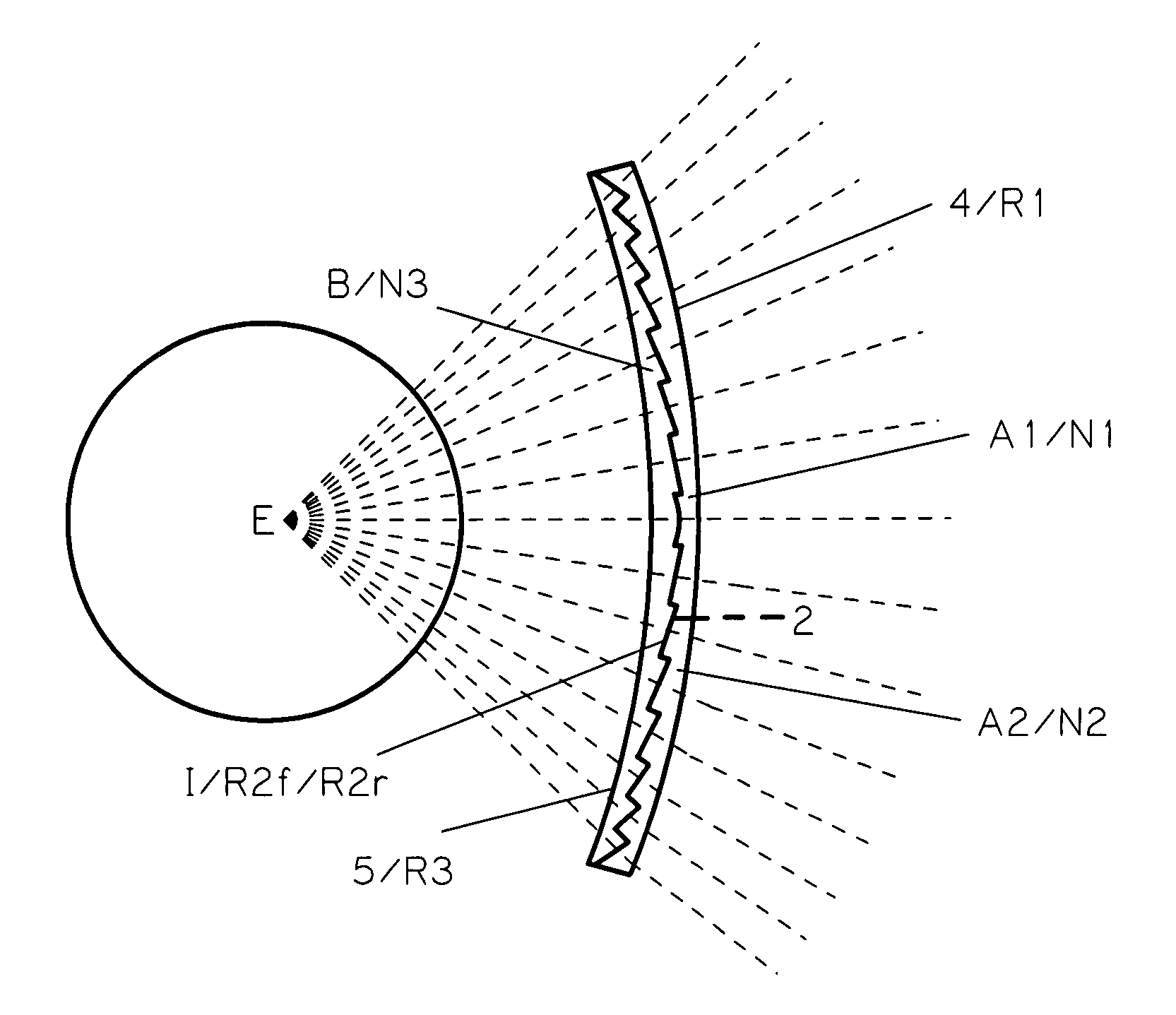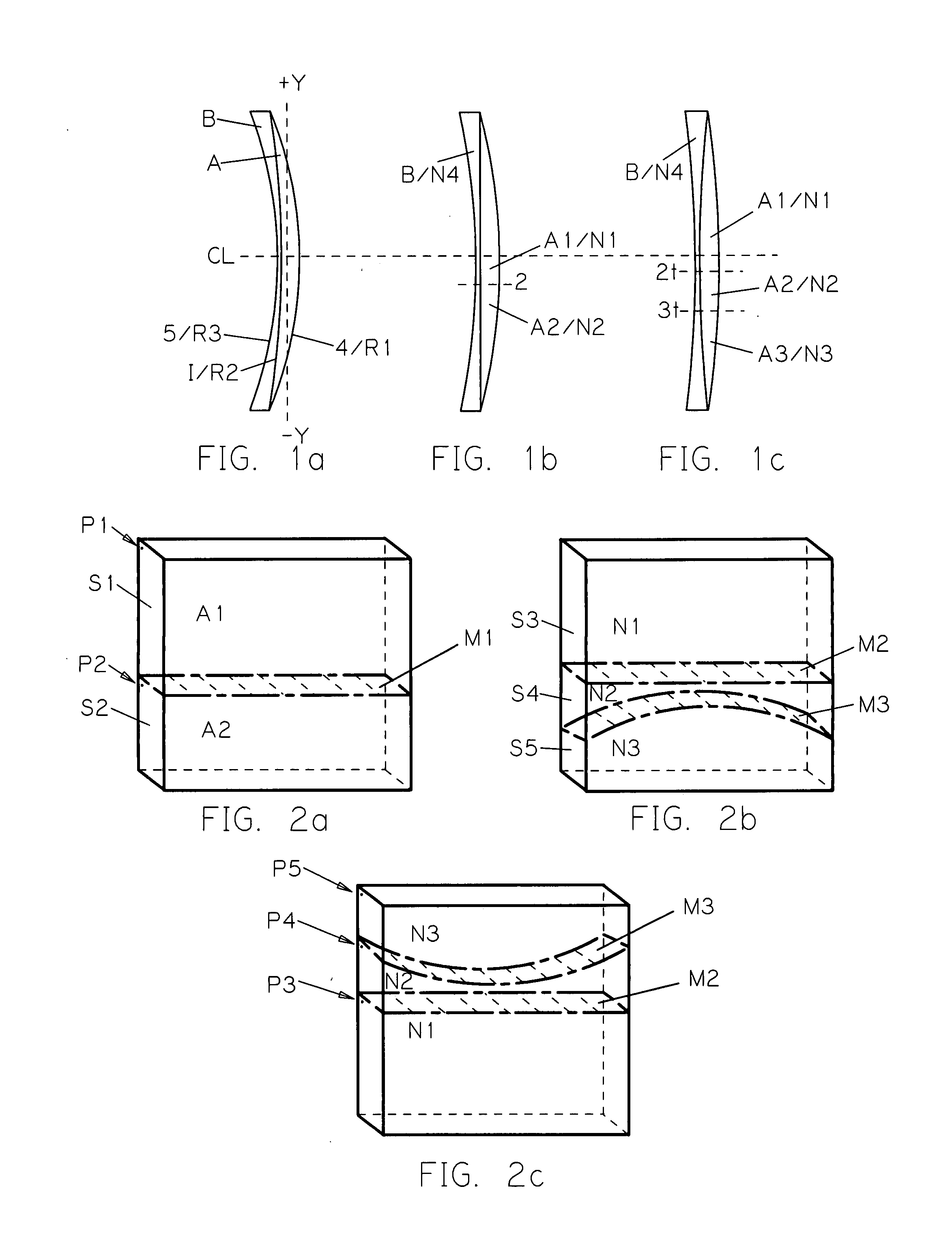Multi-layered multifocal lens with blended refractive index
a multi-layered, multifocal technology, applied in spectacles/goggles, instruments, spectacles/goggles, etc., can solve the problems of poor vision, restricted useful area of progressive and near vision zones of lenses, and low popularity of multifocal lenses. achieve the effect of improving optical attributes
- Summary
- Abstract
- Description
- Claims
- Application Information
AI Technical Summary
Benefits of technology
Problems solved by technology
Method used
Image
Examples
first embodiment
[0097]FIG. 5 is a table listing the CREN values of a complement of lenses of the first embodiment according to the RID of the changing refractive index layer(s) and add power of the lens. The refractive index values for all calculations are those listed above with reference to FIG. 4. Add powers in the table range from 1 to 3.5 diopters. The CREN numbers for the example lenses above, having all parameters the same except for lens form, range from 18.436 to 18.729, and define the major portion of the 18.07-19.10 range listed in the category at the intersection of the 0.24 RID and the 2.5 diopter add. The category range on the chart has been widened by 2% beyond the numerical range of the example lenses to 18.07-19.10 to include additional lens forms not included in FIG. 4. The other category ranges in FIG. 5 likewise have been widened by 2%. The 18.07-19.10 CREN range represents a very usable but just medium efficiency group of changing refractive index lenses of the present inventio...
third embodiment
[0110]Referring to FIG. 9 there is shown a doublet lens configuration of the invention. Anterior lens section A comprises a generally constant refractive index layer, a right at the I are I in and lens section B comprises the changing refractive index layer of the lens. Section A has minus power and section B has plus power. In the two examples provided the internal interface curvature R2 is concave with respect to section A. In this embodiment the refractive index of the near vision portion is greater than that of the distance vision portion, therefore providing add power for near vision.
[0111]Using similar conventions for identifying and defining the lens as shown in the previously illustrated embodiments and examples, lens layer B is comprised of an optically transparent material having two portions with different refractive index values. B1 corresponds to the distance vision portion of the lens and has a refractive index value N1. B2 corresponds to the near vision portion of the...
fourth embodiment
[0113]Referring to FIGS. 10a, 10b and 10c there are shown three doublet lens configurations of the invention. Collectively, anterior lens section A comprises a generally constant refractive index section of the lens and section B comprises the changing refractive index section of the lens. Section A has plus power and section B has minus power. Anterior surface 4 of lens layer A has a curvature with a radius value R1, internal interface I has a curvature R2, and posterior surface 5 of lens section B has a curvature with a radius value R3. In this embodiment the refractive index of the distance vision portion is greater than that of the near vision portion, therefore providing add power for near vision.
[0114]Separately, FIG. 10a shows the embodiment wherein the internal interface curvature R2 is concave with respect to lens section A, FIG. 10b shows the embodiment wherein the internal interface curvature is piano, and FIG. 10c shows the embodiment wherein the internal interface curva...
PUM
| Property | Measurement | Unit |
|---|---|---|
| sizes | aaaaa | aaaaa |
| sizes | aaaaa | aaaaa |
| refractive indices | aaaaa | aaaaa |
Abstract
Description
Claims
Application Information
 Login to View More
Login to View More - R&D
- Intellectual Property
- Life Sciences
- Materials
- Tech Scout
- Unparalleled Data Quality
- Higher Quality Content
- 60% Fewer Hallucinations
Browse by: Latest US Patents, China's latest patents, Technical Efficacy Thesaurus, Application Domain, Technology Topic, Popular Technical Reports.
© 2025 PatSnap. All rights reserved.Legal|Privacy policy|Modern Slavery Act Transparency Statement|Sitemap|About US| Contact US: help@patsnap.com



